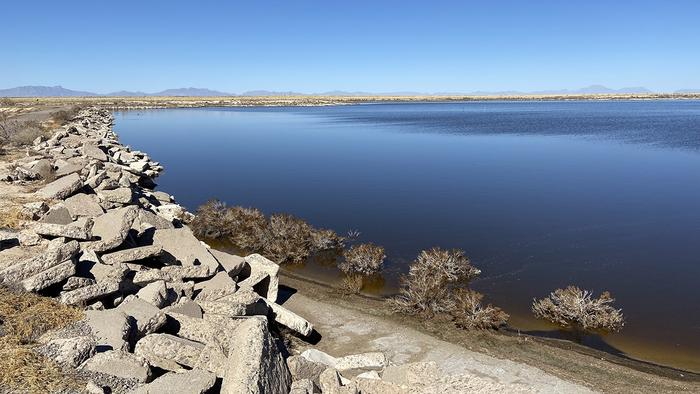A pioneering team of researchers from The University of New Mexico’s Museum of Southwestern Biology (MSB) has unveiled groundbreaking findings about pervasive and unprecedented levels of PFAS contamination in wildlife and the environment at Holloman Lake, located near Alamogordo, southern New Mexico. First detected in 2021, their investigations into per- and polyfluoroalkyl substances (PFAS)—a widespread class of persistent industrial chemicals—have now culminated in a detailed ecosystem-wide assessment that reveals alarming contamination magnitudes with profound ecological and health implications.
Holloman Lake, a desert oasis nestled within the confines of Holloman Air Force Base, has become an inadvertent natural laboratory providing crucial insights into the behavior, transport, and bioaccumulation of PFAS compounds in a heavily impacted environment. Hydrologically complex, this wastewater lake supports rich biodiversity, including thousands of waterfowl and shorebirds, which underscore the ecological stakes of contamination found deep within its sediments, waters, flora, and fauna.
The contamination, linked primarily to decades of aqueous film-forming foam (AFFF) use by military operations, presents one of the most striking cases of PFAS exposure recorded globally. Researchers have identified concentrations in various biotic and abiotic samples exceeding 10,000 times the Environmental Protection Agency’s (EPA) drinking water standards, including a staggering 120,000 nanograms per gram detected in the liver tissue of a native kangaroo rat. Such concentrations represent levels previously unseen and raise critical questions about chronic exposure pathways.
.adsslot_qdg7EhsA0i{ width:728px !important; height:90px !important; }
@media (max-width:1199px) { .adsslot_qdg7EhsA0i{ width:468px !important; height:60px !important; } }
@media (max-width:767px) { .adsslot_qdg7EhsA0i{ width:320px !important; height:50px !important; } }
ADVERTISEMENT
This comprehensive study expands prior work by encompassing an integrated analysis of multiple environmental media—water, soils, plants, algae, fish, reptiles, birds, and mammals—thus providing a holistic view necessary to understand the fate and transport dynamics of PFAS compounds within this desert ecosystem. The research meticulously characterizes PFAS distribution, molecular profiles, and environmental behaviors influenced by local geology such as gypsum deposits, sediment properties, and intermittent inundation events.
One particularly notable finding is the demonstration that air-borne transport is not the primary driver for soil contamination in the region. Instead, historical flooding and overflow episodes, where PFAS-laden wastewater traversed beyond the lake’s boundaries, have contributed to widespread soil accumulation downstream. This is a critical insight, as it alters the conceptual model of contaminant dispersal and calls for renewed focus on hydrological vectors in contamination assessments.
Researchers also elucidated how molecular characteristics of PFAS, specifically chain length and fluorination degree, dictate their environmental persistence and mobility. Longer-chain PFAS molecules exhibited reduced desorption from aquatic systems, implicating mineral interactions—particularly with clay and salt components—as key modulators of contaminant transport. These mechanistic revelations enrich the understanding required for predictive modeling of PFAS behavior in complex environmental matrices.
Moreover, this study raises pressing public health concerns, especially concerning subsistence hunters. Species such as oryx, which regularly visit Holloman Lake and are subject to hunting in New Mexico, could act as vectors transferring PFAS to humans through contaminated meat consumption. As a direct response, collaborations with the New Mexico Department of Game and Fish are underway to evaluate exposure risks, emphasizing the intersection of environmental contamination and human health.
The geographic scope of the contamination remains a formidable unknown, with the boundaries of affected areas beyond Holloman Lake yet to be defined. Satellite and historical imagery reveal episodic spillovers into downstream playas—including those extending toward the ecologically sensitive White Sands National Park—which serve as vital habitats for migratory birds. These insights underscore the potential for contamination to affect distant ecosystems, with migratory species possibly redistributing PFAS across broad landscapes.
This research accentuates the urgent necessity for enhanced environmental monitoring and regulatory oversight. The severity and persistence of PFAS contamination at Holloman Lake typify the challenges posed by ‘forever chemicals’, whose resistance to degradation makes remediation particularly challenging. The authors underscore a critical need for integrated, long-term ecological surveillance to manage and mitigate these pervasive pollutants effectively.
Beyond localized impacts, this natural experiment opens avenues to refine risk assessment frameworks related to legacy and emerging PFAS compounds. Its comprehensive dataset contributes essential empirical parameters for refining environmental fate models, which are crucial for developing science-based policies and protective standards that safeguard both wildlife and human communities.
The study is a clarion call emphasizing the far-reaching consequences of anthropogenic chemical contamination in today’s rapidly changing world. These persistent substances not only jeopardize isolated environments but simultaneously challenge our capacity to protect interconnected ecosystems and public health, urging the global scientific and regulatory community toward more proactive stewardship.
In conclusion, the findings from the Holloman Lake investigation present a stark testament to how military legacy pollution, complex ecological interactions, and chemical persistence intertwine to create high-risk contamination hotspots. Ongoing research efforts, enhanced monitoring, and cross-agency collaborations will be indispensable to confront and address the multifaceted implications of PFAS contamination documented in this emblematic desert oasis.
Subject of Research: PFAS contamination and its environmental behavior and bioaccumulation in the ecosystem of Holloman Lake, New Mexico.
Article Title: Ecosystem-wide PFAS characterization and environmental behavior at a heavily contaminated desert oasis in the southwestern U.S.
News Publication Date: 26-May-2025
Web References:
Research article
UNM news article
Museum of Southwestern Biology
Image Credits: Jean-Luc Cartron
Keywords: PFAS contamination, Holloman Lake, aqueous film-forming foams, bioaccumulation, environmental fate, desert oasis, wildlife exposure, toxicology, migratory birds, environmental monitoring, persistent pollutants, New Mexico
Tags: AFFF usage and contaminationbioaccumulation of PFAS in ecosystemsecological assessment of PFASenvironmental impact of industrial chemicalsEPA drinking water standards violationshealth implications of PFAS exposureHolloman Air Force Base pollutionper- and polyfluoroalkyl substances researchPFAS contamination in Holloman Lakewastewater lake biodiversitywaterfowl and shorebirds contaminationwildlife exposure to PFAS





